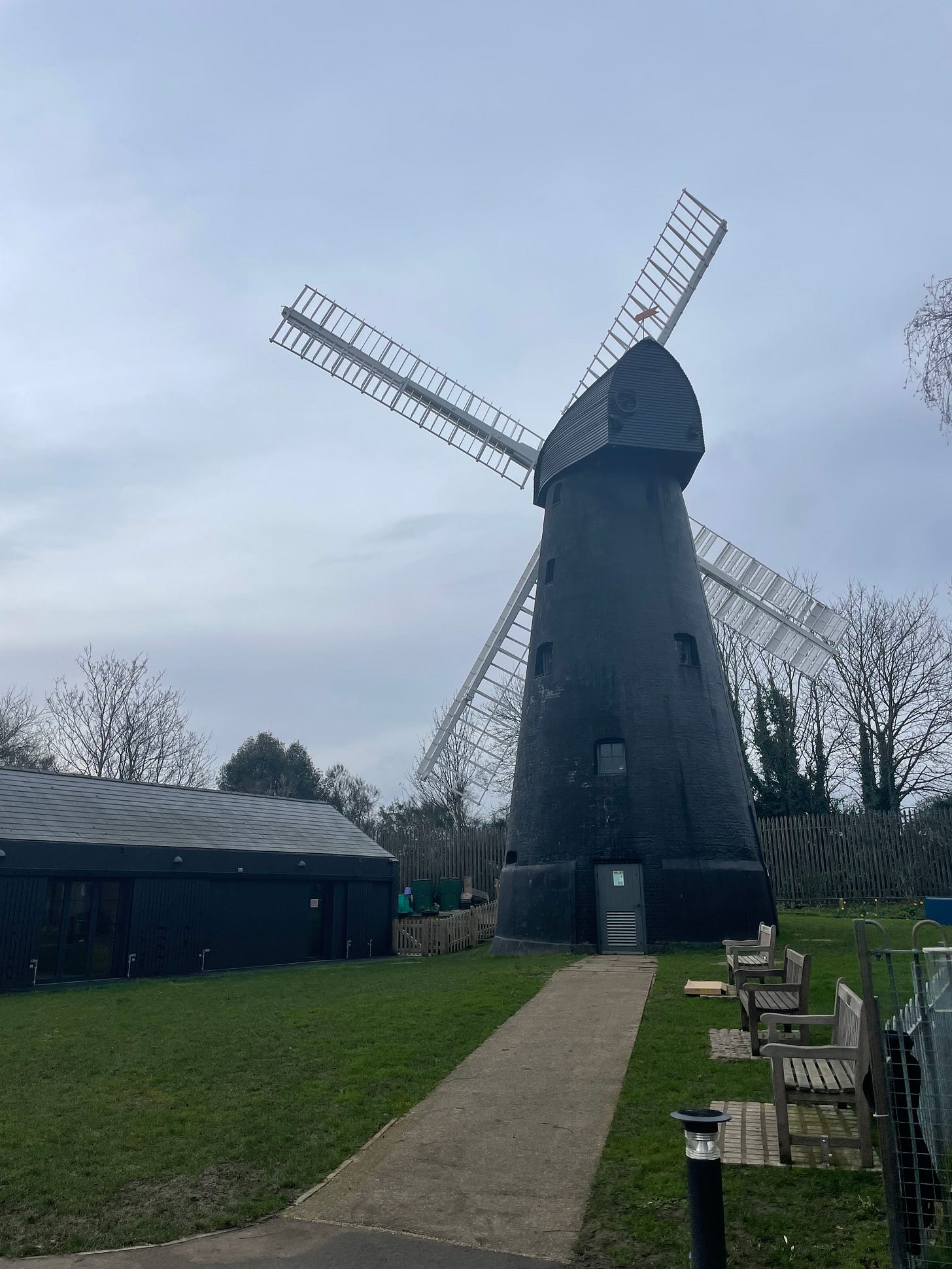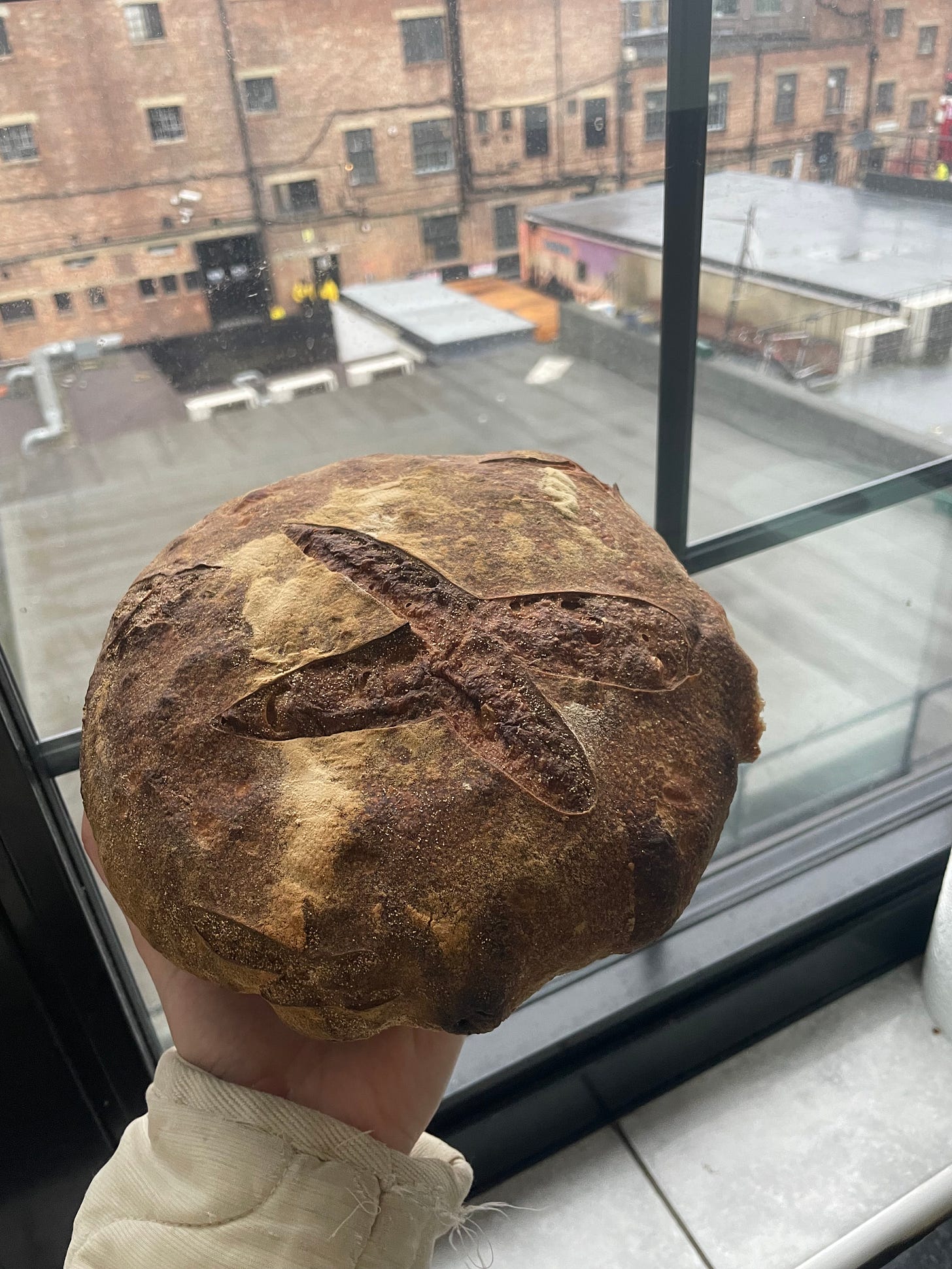As many of you know I have just moved to London, Brixton specifically, and on moving here I decided to search up ‘top 10 things to do in Brixton’ in a similar way to what one does when they are on holiday. Go visit the Brixton Windmill came up high in the rankings and this sparked my interest, as it said to be the last working windmill in London. They also offered a baking and milling day which made perfect sense as I had just moved down from the Lake District, where I had spent a month working in an artisan sourdough bakery.
The day was split between time spent touring round the windmill with Abel the head miller, to being taught how to make sourdough using flour fresh from the mill by Harvey from Toad Bakery in Peckham. Making sourdough in this setting was a great medium between my home experience—using a lengthy 36-hour recipe—and my commercial bakery job, where I was just a cog in the production line, shaping dough without much insight into the full process. With making sourdough, even if you follow the most precise recipe to a tee, there is still so much room for it to go wrong due to the variables involved. The most important of these is temperature, as the dough is a living being that can over proof or under rise if you don’t adjust timings with your room temp. Harvey, our baker, sadly informed me that my four month old starter had probably died as there is a layer of clear liquid sitting above it. However, a good tip for checking if your sourdough starter is working is to put a drop in a glass of water, and if it floats, then it is alive and working.
While we were waiting for our dough to rise we got to have a tour round the mill. It unfortunately doesn’t run off wind power anymore, and hasn’t for a while, because the housing development around it obstructed the wind flow so they now need to use electricity. Other new components that have been added to the mill also include a fixed staircase, as apparently the miller used to hop onto the sail to take them to higher floors beforehand. The mill now operates every six weeks and is purely run by volunteers. Because of this they only have the capacity to supply a few local shops and bakeries such as Toad. The wheat they normally use comes from a supplier just outside of London, but there is apparently a group chat full of farmers and millers where they can announce when a new crop is done and mills run to bid for the crop. At one point they even used to have some wheat growing right outside the windmill, but this would only make enough flour to fill the small dimple in your hand.
Our tour started at the top of the windmill, which has amazing views overlooking the skyscrapers of central London. It is where all of the machinery to run the sails is kept and these have to be manually put into action every so often to prevent them rotting. We then made our way down to the floor below where the grain is stored and lowered when needed. The next floor down after this is the mill itself, the original kind, a Victorian piece of equipment that feels like it’s going to de-limb you if you venture too close. Inside the machine are the millstones, these rub together, crushing the grain and are shaped in a way so that the flour is pushed out of the side when crushed. The markings can also differ depending on what grain you are wanting to turn into flour.
Following our tour we returned to the bread. The loaves Harvey had prepared yesterday and left to rise over night were now ready to bake. For a successful sourdough loaf you need to be able to create a steamy environment when baking. For home cooks, the easiest way to do this is to either use a dutch oven, or to place two baking stones in your oven to trap the heat and then leaving a container of water at the bottom of the oven. As you can see in the final picture, Harvey likes a dark crust, which has that slightly more bitter taste. This isn’t the preference of all, as he apparently needs to convince many of his customers that the loaves aren’t burnt, just browned.
To end the day, we sampled five different types of bread, ranging from a freshly baked wholemeal loaf made with Brixton Windmill flour to rye breads with caraway seeds, which have a more distinctive, polarising anise flavour. The most noticeable thing with the bread tasting however wasn’t actually the different tastes and grains, but rather the difference in texture and quality of a bread that has just come out of the oven, compared to a loaf that is a day old. I will therefore finish off this blog post by giving a suggestion of how best to use your loaf depending on how long ago it was cooked.
Day 1- Straight out of the oven, leave to rest for two hours to prevent it going sticky on the inside then slice and have as bread with a thick slab of salted butter.
Day 2 - The bread is beginning to dry out a bit now, it will probably taste better as toast.
Day 3 - Bruschetta may be a good idea now that it is turning towards stale, simply fry up a slice of sourdough in the pan using some EVOO.
Day 4 - An Italian panzanella salad should now be on the cards, it requires stale bread so that it can soak up all of the dressing without becoming soggy.
Day 5 - Blitz up any remaining bread into breadcrumbs, all the moisture has now gone, which is exactly what’s needed to make those extra crispy crumbs.







